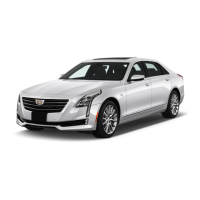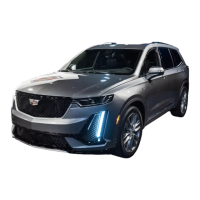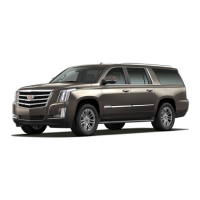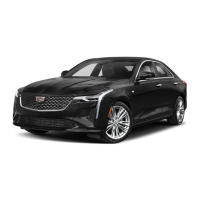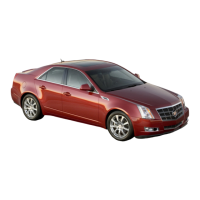
Do you have a question about the Cadillac CT6 2020 and is the answer not in the manual?
| Brand | Cadillac |
|---|---|
| Model | CT6 2020 |
| Category | Automobile |
| Language | English |
Explains how to locate information using the index and page numbers.
Defines hazard symbols and their meanings to avoid injury or death.
Details the operation of keys, remote keyless entry systems, and door locks.
Describes how to lock and unlock doors and access the trunk without removing the RKE transmitter.
Explains how to program new RKE transmitters to the vehicle, including with and without existing recognized transmitters.
Details how to use the keyless access system for unlocking doors and the trunk with the RKE transmitter.
Covers the operation of power door locks via the remote or interior switch, including delayed and automatic locking features.
Explains how the system prevents locking the driver out if a door is open or a transmitter is inside.
Describes the rear door safety locks that prevent passengers from opening rear doors from inside the vehicle.
Covers opening the trunk, including manual operation and precautions regarding exhaust gases entering the vehicle.
Explains how to open and close the power trunk, including obstacle detection and hands-free operation.
Details operation of the hands-free power trunk using a kicking motion under the rear bumper.
Explains the projected logo feature which displays a vehicle logo on the ground near the rear bumper.
Explains the anti-theft alarm system, its indicator light status, arming, and disarming procedures.
Details additional theft-deterrent features like power sounder, inclination, and intrusion sensors.
Recommends deactivating intrusion and inclination sensors for pets or transport.
Details how the immobilizer system works automatically and how it is disarmed when starting the vehicle.
Warns about convex mirror's appearance and provides convex mirror's surface explanation.
Explains how to adjust power mirrors using the selector switch and arrows, and how to use remote mirror folding.
Describes the Lane Change Alert system and its function.
Details how to fold and unfold power mirrors remotely using the RKE transmitter.
Explains how to adjust the rearview mirror for a clear view behind the vehicle.
Describes the automatic dimming rearview mirror that reduces glare from headlamps behind.
Explains the rear camera mirror feature which provides a wide-angle camera view of the area behind the vehicle.
Details how power windows operate, including safety warnings, lockout features, and express movement.
Explains the feature that stops rear passenger windows from working, engaged with an indicator light.
Explains how to override the automatic reversal system by pulling and holding the window switch.
Provides steps to program power windows if they are unable to express-up.
Enables remote operation of windows using the RKE transmitter.
Explains how to pull up and attach sunshades to the holder at the top of the window.
Details sunroof operation requirements and controls, including slide and tilt switches.
Explains express-open/express-close operation of the sunroof using the slide switch.
Details vent feature operation and how to close the sunroof vent.
Explains how to open or close the front sunroof sunshade.
Explains the adjustability and proper positioning of head restraints for safety in a crash.
Details power seat adjustment, lumbar support, thigh support, reclining seatbacks, memory seats, and heated/ventilated seats.
Covers rear seat features like the rear seat reminder system, adjustments, and armrest controls.
Provides comprehensive information on seat belt usage, safety, and related systems like pretensioners.
Details the vehicle's airbag system, including types of airbags and their locations.
Covers child restraint types, placement, and installation for safety.
Details front seat adjustments, including head restraints and power seat functions.
Explains rear seat head restraint adjustment and non-removable design.
Explains how to adjust the driver and passenger seats forward/rearward and cushion height.
Details how to adjust lumbar support forward/rearward and upward/downward for comfort.
Covers settings for seat entry memory movement based on vehicle start.
Explains how to identify the driver number associated with RKE transmitters for memory recalls.
Provides instructions to save preferred driving positions and exit positions linked to RKE transmitters.
Explains how seats automatically heat/ventilate based on interior temperature, and how to control them.
Explains the system that alerts the driver to check the rear seat for items or passengers before exiting.
Details how to adjust rear seats, including seatback display, lumbar, and power seat controls.
Explains the physics behind how seat belts work to slow occupants with the vehicle.
Addresses common questions about seat belts and airbags, and legal requirements.
Provides rules for wearing seat belts correctly, including proper positioning and fit.
Explains how to properly wear the lap-shoulder belt, including locking features and height adjusters.
Locates frontal, knee, and side-mounted airbags within the vehicle's interior.
Explains that airbags inflate when impact exceeds specific system deployment thresholds.
Describes the deployment process involving sensing systems, inflators, and airbag modules.
Details what occupants might see or feel after airbag inflation, including smoke and heat.
Explains the system that detects front outboard passenger presence and determines airbag inflation.
Provides guidance on seat belt usage for older children who have outgrown booster seats.
Emphasizes the need for child restraints for infants and young children, and warnings about shoulder belts.
Describes the rear-facing restraint which uses the seating surface against the infant's back.
Explains the forward-facing restraint that provides restraint for the child's body with a harness.
Describes booster seats used for children who have outgrown forward-facing restraints to improve seat belt fit.
Details how to securely install child restraints using vehicle seat belts or LATCH systems.
States that children are safer in rear seating positions, and provides warnings about front seat placement.
Identifies lower anchors as metal bars built into the vehicle for LATCH seating positions.
Explains the top tether anchor's purpose in securing the top of child restraints and reducing forward movement.
Shows locations of lower anchors and top tether anchors in the rear seat.
Lists and describes various storage locations such as the glove box, cupholders, and armrest storage.
Explains how to access storage via a release cover on the instrument panel.
Details how to open the glove box using the button and closing it manually.
Explains how to extend and close the cupholders from the rearseat armrest.
Describes accessing armrest and cupholder storage areas, and rear armrest storage.
Explains how to access storage compartments in the rear doors.
Describes accessing the center console storage area, which contains USB ports.
Details how to access the trunk through the rear seat pass-through door.
Mentions cargo tie-downs for securing loads and convenience nets.
Explains the use of the convenience net in the trunk for small loads.
Details various controls including steering wheel adjustment, controls, horn, wipers, clock, and power outlets.
Explains various warning lights, gauges, and indicators that signal vehicle system status or potential problems.
Covers Driver Information Center (DIC) and Head-Up Display (HUD) for vehicle information.
Explains messages displayed on the DIC indicating vehicle status or required actions.
Covers personalization of various vehicle features and settings, such as climate control and driver assistance systems.
Explains the Rainsense system that controls wiper sensitivity based on windshield moisture.
Explains how to use the steering wheel controls to navigate the interactive display area in the instrument cluster.
Details how to select and control audio features via the cluster menu.
Explains how to access phone functions, manage calls, and switch to handset operation via the cluster menu.
Describes how to use navigation features, including route guidance and voice prompts, through the cluster menu.
Covers options within the cluster menu, such as unit selection and customization of displays.
Describes a configuration with three interactive display zones.
Describes a configuration with three interactive display zones.
Describes a configuration with two interactive display zones, specific to V-Series models.
States that the cluster can display information regarding Navigation, Audio, and Phone.
Describes how to use navigation features, including route guidance and voice prompts.
Details how to select and control audio features via the cluster menu.
Explains how to choose between U.S. or metric units for displayed information.
Details selecting items for display in the Driver Information Center (DIC) info displays.
Explains how to change the cluster configuration by selecting different layouts.
Allows setting a speed limit and receiving warnings if exceeded, with a pop-up alert and chime.
Explains how to adjust the angle of the HUD image for optimal visibility.
Mentions open source software used in the Wireless Charging Module from LG Electronics.
Provides information on the infrared night vision image feature for detecting pedestrians and animals.
Alerts the driver to fasten their seat belt, with a light that stays solid until buckled.
Explains the DIC display in the instrument cluster, showing vehicle system status and messages.
Guides on how to turn DIC info displays on or off through the Options menu.
Lists all possible DIC displays, including speed, trip data, fuel economy, and fuel range.
Displays vehicle speed in km/h or mph.
Shows current distance, average fuel economy, and average speed since the last reset.
Indicates approximate driving distance on remaining fuel and fuel economy performance.
Displays approximate average liters per 100 km or miles per gallon, calculated since the last reset.
Shows average vehicle speed in km/h or mph, calculated since the last reset.
Allows starting, stopping, and resetting a timer to track elapsed time.
Shows the direction the vehicle is driving, using GPS and other system data.
Displays the current speed limit, sourced from a roadway database.
Allows setting a speed limit and receiving warnings if exceeded, with a pop-up alert and chime.
Shows the set speed for cruise control or Adaptive Cruise Control.
Displays the current follow time to the vehicle ahead as a time value.
Provides info on LKA, LDW, ACC, FCA, and current ACC timing settings.
Shows the current battery voltage.
Estimates remaining useful life of engine oil and indicates when an oil change is needed.
Shows the estimated remaining life of the engine air filter and indicates when it should be replaced.
Estimates remaining life of front and rear brake pads and displays messages when replacement is needed.
Shows approximate tire pressures for all four tires and indicates low pressure.
Shows the odometer reading.
Allows for no information to be displayed in cluster info areas.
Displays digital speed in English or metric units, speed limit, and vehicle ahead indicators.
Displays digital speed and audio information, including radio station and media type.
Displays digital speed and phone information, including incoming calls.
Displays digital speed and turn-by-turn navigation information.
Includes speed view information, rpm, transmission positions, and gear shift indicator.
Alerts regarding safety systems like lane departure and collision alerts.
Displays alerts and messages about vehicle status and required actions.
Displays digital speed, speed limit, and driver assistance system status.
Displays speed information along with audio and phone details.
Shows speed and turn-by-turn navigation information.
Indicates when vehicle propulsion power is reduced, affecting acceleration.
Shows messages indicating the vehicle speed has been limited for various reasons.
Specifies airflow settings for the climate control fan when set to Auto Fan.
Switches the system to Recirculation Mode based on outside air quality.
Automatically activates ventilated seats based on interior temperature.
Automatically turns on and regulates heated seats when cabin temperature is cool.
Automatically turns the front defogger on when the engine is started.
Automatically turns the rear defogger on when the engine is started.
Helps purify interior air by removing contaminants like pollen and dust.
Covers various systems that provide alerts or detect potential collisions, including FCA, LDW, and LCA.
Specifies the type of vehicle feedback, such as beeps or seat vibration, for collision warnings.
Controls vehicle response to detected vehicles ahead, including FCA and AEB functions.
Sets the volume level for audible alerts and chimes.
Tilts mirrors downward when in Reverse to improve visibility of the ground near rear wheels.
Allows remote folding/unfolding of exterior mirrors using the RKE transmitter.
Automatically turns on wipers when moisture is detected and the wiper switch is in intermittent mode.
Flashes headlamps when the RKE transmitter is pressed.
Controls exterior and interior lights that turn on for a set time after the ignition is turned off.
Mentions that exit lighting can be changed through vehicle personalization.
Prevents the driver door from locking when it is open.
Allows selection of which doors automatically unlock when the vehicle is shifted into Park.
Delays the locking of the vehicle’s doors after they are closed.
Flashes exterior lamps when the vehicle is unlocked with the RKE transmitter.
Specifies how the vehicle responds when locked with the RKE transmitter (lights, horn).
Specifies whether all doors or just the driver door unlock when pressing the RKE transmitter.
Turns ventilated seats on automatically during remote start on warm days.
Turns heated seats on automatically during remote start on cold days.
Enables remote operation of windows using the RKE transmitter.
Specifies which doors unlock when using the driver door handle button.
Specifies if the vehicle automatically locks after doors are closed and the driver walks away with the RKE transmitter.
Sounds an alert when the RKE transmitter is left in the vehicle.
Describes automatic seat recalls based on RKE transmitter or manually recalled positions.
Describes automatic seat recalls based on RKE transmitter or manually recalled positions.
Details how to use the universal remote system and erase programmed buttons.
Provides step-by-step instructions for programming up to three devices, including troubleshooting for Canada/gate operators.
Covers programming adjustments for Canadian radio-frequency laws and some gate operators.
Details exterior lamp controls, high/low beam changer, flash-to-pass, DRLs, automatic headlamps, and signals.
Covers instrument panel illumination, courtesy lamps, dome lamps, and reading lamps.
Explains features like entry lighting, exit lighting, battery management, and savers.
Guides on how to enable the IntelliBeam system via the turn signal lever.
Explains when the system activates high beams and how the indicator light works.
Activates headlamps, parking lamps, and other exterior lamps when wipers are used in daylight.
Explains how entry lighting automatically turns on when the RKE transmitter is detected within a certain range.
Mentions that exit lighting can be changed through vehicle personalization.
Describes the battery saver feature designed to protect the vehicle's battery.
Explains how exterior lamps turn off automatically after a period to prevent battery drain.
Introduces the infotainment system and its related components.
Refers to the infotainment manual for detailed information on various system features.
Reduces engine noise in the vehicle’s interior using factory-installed audio system components.
Covers automatic climate control systems (Dual Zone and Quad Zone) for heating, cooling, and ventilation.
Details the location and adjustment of adjustable air vents in the instrument panel and other areas.
Covers passenger compartment air filter replacement and general service information.
Explains how the system automatically controls fan speed, air delivery, and recirculation for desired temperature.
Details changing airflow direction by touching desired air delivery modes on the climate control display.
Explains how the system automatically controls fan speed, air delivery, and recirculation for desired temperature.
Provides tips for better fuel economy, distracted driving awareness, defensive driving, and drunk driving.
Covers new vehicle break-in procedures, ignition positions, starting the engine, and stop/start systems.
Warns about the dangers of carbon monoxide (CO) from exhaust fumes entering the vehicle.
Details the shift pattern, gear positions, and operation of the automatic transmission.
Explains the All-Wheel Drive system and its automatic operation for road conditions.
Covers electric brake boost, ABS, electric parking brake, and brake assist systems.
Details Traction Control/Electronic Stability Control and Driver Mode Control systems.
Explains how to set, resume, increase, and decrease speed with cruise control, and its limitations.
Covers systems that help avoid crashes or reduce damage, including FCA, LDW, LKA, and APA.
Explains the Super Cruise system for maintaining lane position on compatible highways, and its limitations.
Explains how the steering system varies effort based on vehicle speed for maneuverability and control.
Details the electric power steering system, its lack of fluid, and potential issues.
Describes three types of skids: Braking, Steering/Cornering, and Acceleration, and how defensive driving avoids them.
Explains hydroplaning danger and provides tips to slow down when the road is wet.
Provides tips for driving carefully on snow and ice, including for slippery road conditions.
Advises stopping safely, signaling for help, and using hazard flashers in blizzard conditions.
Shows occupant seating positions, maximum capacity weight, and tire size/pressure.
Guides on calculating available cargo and luggage load capacity based on occupant and cargo weights.
Shows Gross Vehicle Weight Rating (GVWR) and Gross Axle Weight Rating (GAWR) on the center pillar.
Provides recommended guidelines for the first 2,400 km (1,500 mi) of driving for optimal performance.
Explains the electronic keyless ignition with pushbutton start and the need for the RKE transmitter.
Details how to turn the engine off, including ignition status and Retained Accessory Power (RAP).
Allows use of some electrical accessories when the engine is off.
Indicates the mode for driving and starting the vehicle.
A power mode for service and diagnostics, verifying lamp operation for emission inspections.
Provides starting procedures for P (Park) or N (Neutral), and when the vehicle is already moving.
Explains the system that shuts off the engine to conserve fuel and its components for increased starts.
Describes how the engine may turn off at a complete stop and restart automatically.
Explains how to disable the automatic engine Stop/Start function using a button on the center stack.
Provides instructions for using the engine heater in cold weather for easier starting and better fuel economy.
Explains how to enter and exit manual mode using shift lever and controls for current driving conditions.
Describes controls on the steering wheel for manually shifting the automatic transmission.
Explains the AWD system, which sends engine power to all wheels automatically for road conditions.
Details vehicles with electric brake boost, electronic control of hydraulic circuits, and routine tests.
Explains how ABS helps prevent braking skids and maintain steering during hard braking.
Covers the Electric Parking Brake (EPB) system, its activation, and warnings about its use.
Detects rapid brake pedal applications and provides additional braking to activate ABS.
Temporarily prevents vehicle rolling on grades during brake pedal release to accelerator apply.
Explains TCS and StabiliTrak/ESC systems that limit wheel spin and assist in maintaining control.
Explains how Driver Mode Control optimizes driving performance through settings for various sub-systems.
Guides on setting cruise control, including speed increments and keeping the system off when not in use.
Explains how to resume a set speed after cruise control disengages due to brake application or button press.
Details how to increase vehicle speed in small or large increments while using cruise control.
Explains how to decrease vehicle speed in small or large increments while using cruise control.
Describes four ways to end cruise control: light brake pedal press, '*' button, shifting to Neutral, or pressing 'J'.
Explains that cruise control set speed is erased from memory if 'J' is pressed or ignition is turned off.
Allows selecting cruise control set speed and following gap, using camera and radar sensors to detect vehicles.
Explains how to switch between ACC and regular cruise control by pressing and holding '*' on the steering wheel.
Guides on setting desired speed for ACC and applying brakes if a vehicle ahead is detected.
Details how to reduce speed using the brake or SET- button while ACC is active.
Explains how to adjust the following gap (Far, Medium, Near) using the steering wheel controls.
Describes how ACC alerts the driver to potential hazards, including collision alerts and tailgating warnings.
Covers Rear Vision Camera, Park Assist, Surround Vision, and other parking assistance systems.
Details systems like FCA, LDW, LKA, SBZA, LCA, AEB, and FPB that help avoid crashes.
Summarizes messages related to Super Cruise unavailability, sensor issues, and system limitations.
Explains the need for periodic map updates for Super Cruise availability on certain roads.
Details how Super Cruise uses the Wi-Fi hotspot to download map updates and GPS enhancement data.
Enables or disables sharing of vehicle location information for various purposes.
Provides instructions for cleaning the camera lens cover on the steering column for optimal performance.
Explains alerts when Super Cruise is not steering or requires manual intervention, indicating red flashing light bar.
States ACC must be on before Super Cruise can be enabled, with set speed and engagement requirements.
Super Cruise is disabled unless Alert and Brake is selected in Collision/Detection Systems.
Indicates no map information or incorrect road type for Super Cruise operation.
Lists conditions like rain, snow, or poor lane markings that inhibit the system's ability to see lane lines.
Identifies conditions like sun glare or obstructions affecting the Driver Attention System camera's view.
States that the DAS system detects when the driver is not looking at the road.
Indicates the vehicle is not centered in lane lines, affecting Super Cruise availability.
Warns if the vehicle is traveling faster than 137 km/h (85 mph), affecting Super Cruise speed in curves.
Indicates the Super Cruise system has detected the vehicle is in an exit lane.
Indicates poor GPS reception or blockage, affecting OnStar and Super Cruise operation.
Indicates the driver has taken control or ACC has been canceled, disengaging Super Cruise.
Instructs to clear snow, ice, dirt, or contaminants from vehicle sensors for Super Cruise operation.
States that some curves are too sharp for Super Cruise navigation, becoming available after the curve.
Indicates Super Cruise is unavailable for reasons not described in other messages.
Occurs when the driver ignores prompts to take control, disabling Super Cruise until the next ignition cycle.
Provides alerts for approaching detected vehicles too rapidly, with flashing display and beeps.
The vehicle ahead indicator displays amber when following a vehicle too closely.
Sets FCA timing to Far, Medium, or Near for collision and tailgating alerts, affecting timing based on vehicle speed.
Indicates the following distance to a vehicle ahead in seconds on the Driver Information Center (DIC).
Explains LKA uses a windshield camera to detect lane markings and provide steering assist or alerts.
Provides guidance on service and parts needs, recommending dealer visits for genuine GM parts and trained technicians.
Covers doing your own service work, hood checks, and engine compartment overview.
Covers tire maintenance, including pressure, inspection, rotation, and replacement, plus wheel alignment.
Provides instructions for safely jump starting a vehicle with a dead battery using jumper cables.
Offers cautions and recommendations for towing disabled vehicles or using tow eyes.
Covers exterior and interior care, including washing, protecting moldings, and cleaning surfaces.
Identifies engine coolant surge tank, air cleaner, cooling fan, oil fill cap, dipstick, and fuse block.
Identifies passenger side engine compartment components including fuse block, coolant, air cleaner, and battery terminals.
Explains how to check engine oil level, including dipstick location and warnings about hot handles.
Provides guidance on adding engine oil, including quantity and operating range.
Details engine oil selection based on specification and viscosity grade, including caution about incorrect oil.
Details engine oil selection based on specification and viscosity grade, including caution about incorrect oil.
Explains the computer system indicating when to change engine oil and filter, and the need to reset the system.
Provides steps to reset the engine oil life system after an oil change.
Lists owner checks like engine oil level, tire inflation, tire inspection, and washer fluid.
Explains when to change engine oil and filter, and the need to reset the oil life system.
Details when to replace the engine air filter and reset the system.
Requires replacement of the desiccant every seven years for longevity and efficient operation.
Explains the 12-volt battery's role and the importance of maintaining its cranking power and connections.
Discusses belt replacement needs if they squeak or show signs of cracking/splitting.
Details signs of brake wear and the importance of trained technicians for inspection and parts.
Explains the importance of proper fluid levels and approved fluids for vehicle systems.
Includes steering wheel vibration, bounce/sway, longer stopping distance, or uneven tire wear.
Covers exterior care for locks, washing, and finish protection, including cautions on cleaning agents.
Provides guidelines for cleaning interior surfaces to prevent dirt abrasions and damage.
Includes pulling, improper vehicle handling, or unusual tire wear.
Includes scratches, cracks, and chips.
Includes streaking, skipping across the windshield, and worn or split rubber.
Outlines steps to resolve concerns, starting with dealership management and escalating if needed.
Provides contact information for US, Puerto Rico, and Canada assistance centers.
Offers assistance for deaf, hard-of-hearing, or speech-impaired customers using TTY equipment.
Provides access to videos, articles, vehicle health, and OnStar account information.
Offers cost reimbursement for eligible aftermarket adaptive equipment like hand controls or wheelchair lifts.
Details roadside assistance coverage, calling procedures, and types of services provided.
Guides on scheduling warranty service, prioritizing safety-related issues.
Offers courtesy transportation options like shuttle service or reimbursement for inconvenience during warranty repairs.
Emphasizes using qualified technicians and proper replacement parts for collision repairs.
Provides information on ordering service manuals and customer literature.
Explains compliance with FCC and ISED rules for vehicle radio frequency systems.
Covers reporting safety defects to US and Canadian governments, and to General Motors.
Explains vehicle computer modules recording performance data and the protection of customer data.
Addresses GM's collection of vehicle usage information and protection of electronic systems from unauthorized access.
Details GM's collection of vehicle usage data and protection of electronic systems from unauthorized access.
Explains the purpose of EDRs in recording crash data to understand system performance.
Covers OnStar services like emergency, security, navigation, and diagnostics, requiring a service plan.
Introduces OnStar services and status lights, connecting to an Advisor via buttons or phone.
Details emergency, security, and remote services requiring an active plan and vehicle systems.
Covers reactivation for subsequent owners, service works, languages, and potential issues.
Explains limitations for remote services after the vehicle has been off for 10 days without ignition cycle.
Discusses GPS signal obstructions in cities, garages, tunnels, and dense trees affecting location accuracy.
Explains TTY capability for communication with OnStar services, excluding Virtual Advisor and Turn-by-Turn Navigation.
